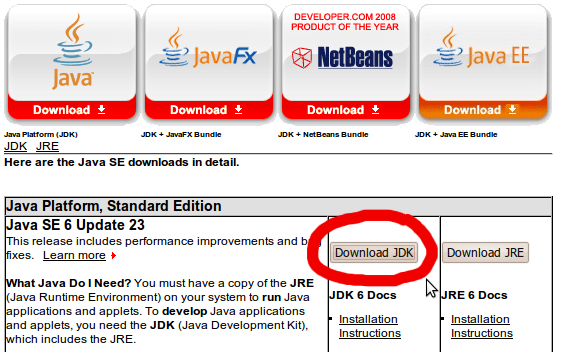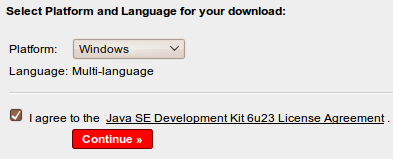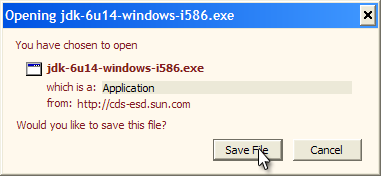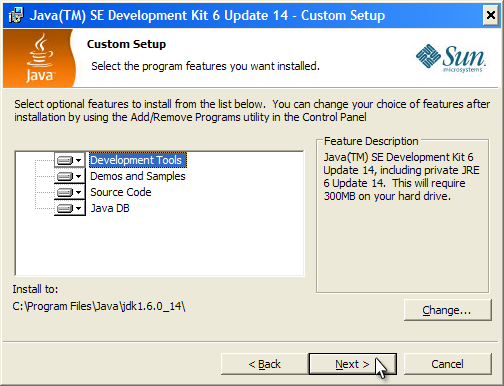Working at Home
(last updated Jan 1 2011)
You will need to install, at most, three pieces of software: The Java Development Kit (JDK), the Eclipse editor, and the jGRASP editor. The directions differ based on your operating system.
- Windows
- Extra information for Windows Vista 64-bit
- Mac
- Linux
- Useful Options for Your Operating System
- Common jGRASP Problems and Errors
Windows users:
1) Install Java Development Kit (JDK)
Follow the above link and click the button labeled, JDK 7u2. (Not the "JRE" link). Please be careful to choose to download JDK and not JRE. JRE just allows you to run other people's Java programs, not compile and create your own programs. You must choose JDK instead.
Note: Sun updates JDK frequently; by the time you read these directions, the version may have increased. The directions should be the same otherwise. Our screenshot below is probably out of date by now as well, since we don't update it unless the page appearance changes.
Accept the License Agreement and choose the "Windows" Platform, multi-language JDK file": jdk-6u23-windows-i586.exe (76.32 MB)
Once you have finished downloading this file to your Desktop, you must install JDK on your system. Do this by double-clicking the JDK installer file you saved on the Desktop.
You can choose all the default options during installation.
2) Download Eclipse editor
Eclipse is an advanced editor, we will not be covering it in class, but you are welcome to learn it on your own. Short instructions for installing it are:
- Go to eclipse.org/downloads.
- Click the link titled "Eclipse IDE for Java Developers". (This is usually the first link in the list; you do NOT want the "IDE for Java EE developers".)
- Download the ZIP file, extract its contents, and then run
eclipse.exeto start the program.
TA Daniel Otero has written a comprehensive tutorial for installing and using Eclipse at the following address:
3) Download jGRASP editor (Suggested Editor)
From the jGRASP web site link above, click the button at top-right labeled Download jGRASP. You will be taken to a download page with some survey information. You may skip this. Underneath the survey is a set of buttons. Click the jGRASP exe to download a file named jgrasp188_03.exe. Save the file to your Desktop or another convenient location.
- NOTE: If you use Windows Vista, you may need to choose to "Download Jar File" rather than "Download Windows App."
Once you have finished downloading this file to your Desktop, you must install jGRASP on your system. Do this by double-clicking the jGRASP installer file you saved on the Desktop. Once you are done installing jGRASP, you should now have icons on your Desktop and in your Start Menu for running jGRASP.

- (Our screenshots probably show an older version number, but the overall process is the same.)


Extra information for Windows Vista 64-bit:
We have had particular problems come up for students using Windows Vista 64-bit edition. If you have Vista but aren't sure whether it's the 64-bit edition, you can follow these instructions to find out:
- Click Start and choose Control Panel
- Click on "System and Maintenance" (upper-left option)
- Click on "System"
- Now you should be seeing "basic information about your system", including whether it is 64-bit

- Double check the folder name where the JDK is stored. You can do this by opening up My Computer, then opening C:\, then opening Program Files, and then opening Java. Look for a folder with "jdk" in its name. On Stuart's computer, the folder is called "jdk1.6.0_11".
- Click Start and choose Control Panel
- Type "environment variable" into the search box
- Click on "Edit the System environment variables"
- Now you should see a screen that is divided into two parts. On top are the "User variables." Down below are the "System variables." It is safer to change the user variables, so click on the "New" button in the upper section to add a new user variable.
- This will bring up a dialog box with two things to fill in. You should
type something like this:
Notice that the variable value includes the directory name "jdk1.6.0_16". If you found that the JDK is stored on a different directory, then use that directory name instead of this one. Everything else should appear exactly as it is listed above with no spaces.Variable name: path Variable value: %path%;c:\program files\java\jdk1.6.0_16\bin - Go to eclipse.org/downloads.
- Click the link titled "Eclipse IDE for Java Developers". (This is usually the first link in the list; you do NOT want the "IDE for Java EE developers".)
- Download the ZIP file, extract its contents, and then run
eclipse.exeto start the program. -
Some students are reporting issues with jGRASP on the Mac. Some report seeing the following strange message:
share cache file is corrupt: /var/b/yl/yl_share_cache_ppc
If you see this message, you should update your Mac to Java v1.6 by running the Mac's built-in Software Update tool. Then re-run jGRASP and click Settings, jGRASP Startup Settings, and set your Java version to 1.6.0.
- Some students are reporting that characters are missing from their
printlnmessages on the console. We don't know what is causing this. If you have this bug, let us know what kind of Mac you have (Intel or PPC? What OS X version? etc.) and we'll try to figure it out. - If you continue having problems with jGRASP, you may want to try another Java editor named DrJava.
- Go to eclipse.org/downloads.
- Click the link titled "Eclipse IDE for Java Developers". (This is usually the first link in the list; you do NOT want the "IDE for Java EE developers".)
- Download the ZIP file, extract its contents, and then run
eclipse.exeto start the program. - Try installing the 32-bit version of JDK (sometimes labeled the "x86" version on the Sun/Oracle download page), or
- Try installing JDK v1.6 instead of 1.7.
For a system that is 64-bit, you will see something like the following (the note about 64-bit appears about three-quarters of the way down):
If you have a Windows-64 machine, then when downloading the JDK, you should list your platform as "Windows x64." There seems to be a problem with jGRASP that it doesn't install properly on 64-bit machines. We are still trying to understand this, so if you have a 64-bit machine and jGRASP installs properly on your machine without any extra configuration, please email Marty to let him know.
Most people are finding that when they try to compile a program, they get an error message like this:
----jGRASP wedge2 error: command "javac" not found. ---- This command must be in the current working directory ---- or on the current PATH to use this function. ---- PATH is ---- "c:\videos;C:\Windows\system32;C:\Windows\system32;C:\Windows;C:\Windows\System32\Wbem;C:\hp\bin\Python;C:\Program ---- Files (x86)\UWICK\SSH Tectia\SSH Tectia AUX;C:\Program Files ---- (x86)\UWICK\SSH Tectia\SSH Tectia AUX/Support binaries;C:\Program Files ---- (x86)\UWICK\SSH Tectia\SSH Tectia Broker;C:\Program Files ---- (x86)\UWICK\SSH Tectia\SSH Tectia Client". ---- ---- Make sure you have the full JDK (J2SE SDK or other), not just the JRE, ---- installed. ---- The J2SE SDK is available from java.sun.com. ----jGRASP: operation complete.
If you are seeing this message, then follow these instructions:
What we are doing in setting up this environment variable is telling the system to look into the "bin" folder (short for "binary") of the JDK installation when it looks for programs like "javac", which is the Java compiler. Once this change is made, you should restart jGRASP and it should work.
If you have any problems, please email Marty.
Mac:
1) Install Java Development Kit (JDK)
Macs with the OS X operating system will have Java available automatically, but you may need to install the latest Mac version of JDK, version 6.0. Some newer Macs (purchased within the last year or so) already have this software, but older ones do not. If you have a fairly new Mac, you may want to try to skip to Step 2 and see if jGRASP works, and if not, come back to this step.
If your Mac doesn't have Java installed already, you can go to this web page to download it:
http://developer.apple.com/java/download/
If you have Mac OS X v10.5 "Leopard" or newer, you want to choose the link that says Java for Mac OS X 10.5, Update 1. If you have the older v10.4 "Tiger" version of OS X, you should choose "Java for Mac OS X 10.4, Release 6". You can see your OS X version by clicking the Apple icon on the top-left of your screen and choosing "About this Mac."
Once you've downloaded the file, double-click it on your desktop to install it.
2) Download Eclipse editor
Eclipse is our suggested primary editing software for this course. Short instructions for installing it are:
TA Daniel Otero has written a comprehensive tutorial for installing and using Eclipse at the following address:
3) Download jGRASP editor
There is a Mac version of jGRASP, available from the same jGRASP web site by clicking the button labeled jGRASP pkg.tar.gz. Download this file and open it, then drag the jGRASP program to your Applications folder to install it.
Common Mac jGRASP issues:
Linux:
(These directions are a few months out of date, but the general idea can still be followed.)
It's tougher to give an installation guide for Linux because of the large variety of different distributions and architectures. Here is a rough guide that will work for many distributions such as Ubuntu.
1) Install Java Development Kit (JDK)
http://java.sun.com/javase/downloads/index.jsp
Follow the above link and click the "Download JDK" button next to the "JDK 6.0 Update 23". (NOT the "with NetBeans 5.0" link or the "with Java EE" link or others). Accept the License Agreement and choose the "Linux self-extracting file" file:
jdk-6u23-linux-i586.bin
(If you use a Linux distribution that supports RPM packages such as Fedora Core, you may wish to use the "Linux RPM in self-extracting file" package.)
Once you have finished downloading the JDK .bin file, open a terminal window and execute the file. You may have to give execution permissions to the file:
chmod +x jdk-6u23-linux-i586.bin ./jdk-6u23-linux-i586.bin
Running the .bin file extracts the JDK contents. Move these to a directory of your choice. (The rest of this tutorial assumes you have moved the JDK to /usr/lib/jdk/ .)
After installing Java, you will probably wish to add Java's directory to your PATH setting, so that you can run Java commands from your terminal. To do so, edit the file .bashrc in your home directory and add the following lines to the end of it:
export PATH=/usr/lib/jdk/bin:$PATH export CLASSPATH=.
You should close your terminal and open a new one for the PATH changes to take effect.
2) Download Eclipse editor
Eclipse is our suggested primary editing software for this course. Short instructions for installing it are:
TA Daniel Otero has written a comprehensive tutorial for installing and using Eclipse at the following address:
3) Download jGRASP editor
There is a Linux version of jGRASP, available from the same jGRASP web site by clicking the button labeled jGRASP zip. Download this file and extract its contents. Then open a terminal and cd to the directory of those contents and type:
java -jar jgrasp.jar
3) Set Up BASH Script File (optional)
If you are unable to get the jGRASP debugger working in Linux, try downloading the following jgrasp BASH script file and putting it in the jgrasp/bin folder. Give it execute permissions (chmod +x) and then use it to run jGRASP.
![]() jgrasp bash script
jgrasp bash script
Useful Options for Your Operating System
Enable File Extensions in Windows:
By default, Windows does not show extensions of certain types of files. This can lead to confusion because you may not know which file is your .java program and which is your .class compiled file.
If you'd like to change this value, open My Computer. From the window's main menu, click the following:
Tools, Folder Options...
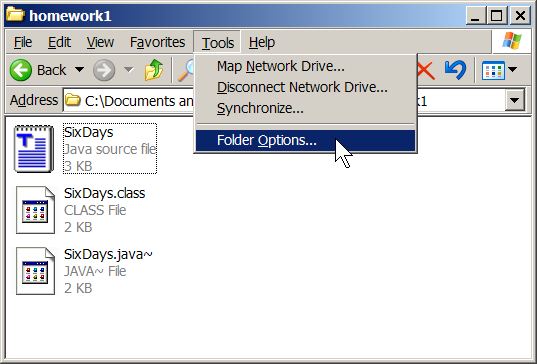
A Folder Options window will appear. Click the tab labeled View, then find the checkbox labeled Hide extensions for known file types. Uncheck it. Press OK.
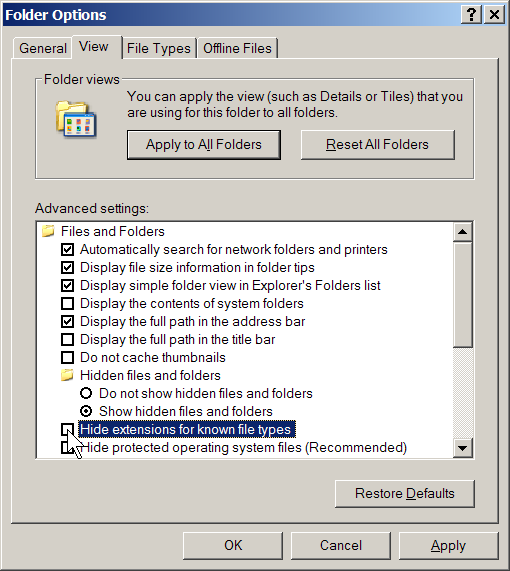
Now all files should show their extensions in Windows.

Common jGRASP Problems and Errors:
International Error Messages:
Some users who have international (Chinese, Korean, etc.) versions of Windows cannot properly see the compiler errors in jGRASP. To fix this problem, follow these steps in jGRASP.
Click "Settings" -> "Compiler Settings" -> "Workspace".
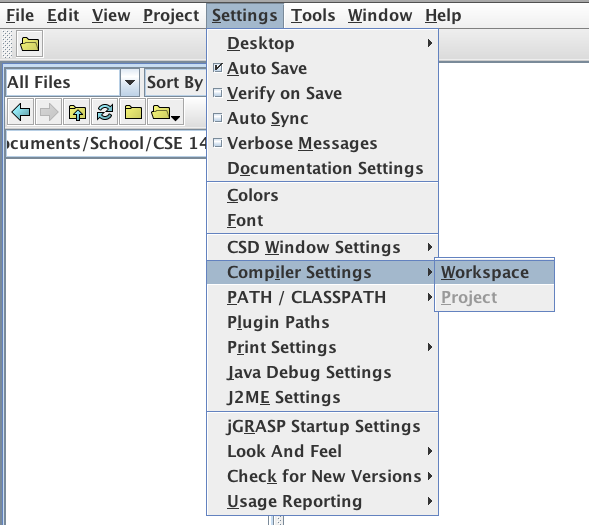
In the settings box that pops up, click the "Flags / Args" tab (in the lower row of tabs). Then, click the black "button" under "FLAGS or ARGS" and next to "Compile". In the text box that becomes available type in "-J-Duser.language=en" (without the quotes) and click "OK".

(Thanks to TA Eric Spishak for writing this tip!)
Unable to install 64-bit jGRASP on Windows 7 / Vista:
Some Windows 7 / Vista users report that their system just sits idle when they double-click the Java JDK installer icon. They are unable to install JDK. Usually this problem can be solved in one of two ways:


 Practice-It!
Practice-It!